Web forms serve as a communication bridge between companies and consumers. They serve as a staple in the marketing strategy and should be an irreplaceable asset on every website. In this article, we dive deep into Webflow forms to help you learn all about them.


What is a web form?
A web form is a web element where your website visitors can enter data and personal information. One of the most common examples is where users share their name and email address to sign up for a newsletter. Web forms essentially serve as a bridge between a company and potential clients.
Web forms are a staple in the marketing strategy. Marketers use web forms for several reasons — to complete an order, keep track of customers' personal information, or collect lead information. According to HubSpot, 28% of marketers say the right form fields help improve lead scoring.
Web forms vary in length, format, purpose, and appearance. Companies use various forms regarding their business goals. The most common web forms you will come across are:
- Contact form
- Lead generation form
- Order form
- Survey form
- Registration form
- Support request form
- Customer feedback form
How to add a form in Webflow?
Normally web forms are created in programming languages like PHP, HTML, or Java. As Webflow is a no-code web builder, you don't have to go through the hassle of coding a basic web form.
To add a form in Webflow, go to Add panel and then to the Form list. You can pick between a few form elements and then drag them onto the canvas.
Initially, the form block inherits the full width of its parent element and contains nested three elements. Those are the form itself, the success message, and the error message.
You can tweak or delete an element within the form without writing a single line of code. Webflow enables you to easily adjust the web form to your brand image and requirements.
Here is a complete list of form elements you can edit:
- Field label - crucial for accessible navigation of your form. It describes a purpose or the function of a form field.
- Input - the purpose is to collect single-line data like name or email address.
- Text area - allows visitors to input multi-line data.
- File upload - enables users to attach a file (example: jpg) to their form submission.
- Radio button - used for input data where the visitor can select only one of many options.
- Checkbox - as the name already suggests, a checkbox is used for a visitor to choose one or multiple options.
- Select - allows you to add a list of different options for your visitor to choose among.
- reCAPTCHA - helps prevent spam.
- Submit button - used to collect all the input data from a user.
General Data Protection Regulation - GDPR
GDPR (General Data Protection Regulation) is a regulation in EU law on data protection and privacy. Implemented in 2018, it protects internet users in the European Union and the European Economic Area.
When you host a website that collects personal data from EU residents, you must do this in compliance with GDPR law. To collect data, you will have to ask for explicit consent from your website visitors.
A good practice is to add a required checkbox field to your published form such as " I consent to XY company collecting and storing the submitted data". As the user has to explicitly give you their consent, the checkbox should not be pre-ticked.
Individuals who fill in your forms have the right to ask you to access personal information you have collected from them. Users also can request that their data be removed from your systems at any time permanently.
Disclaimer: This is not legal advice. Use this guide solely for informational purposes. Complying with the GDPR requires legal action. Work with your legal counsel to determine how privacy laws apply to your specific business.
Troubleshooting
What to do when your form can't be submitted successfully?
- If you’ve enabled reCAPTCHA on your site, make sure all of the forms on your site contain a reCAPTCHA element.
- If you’ve hidden any form fields in your form, make sure that Autofocus is not checked in the settings for those fields.
- Check your Webflow plan. Different plans allow you to get a different number of total form submissions per month. To see, how plans compare to each other, see the Webflow pricing page here.
Disclaimer: If you export your site for external hosting, Webflow will not process form submissions on your site. You will need to use a third-party tool to collect form submissions on the exported site or embed a third-party form integration.
Conclusion
Web forms will help you convey the information to your website visitors.
Knowing who visits your website helps your inbound marketing and lead generation. Web forms also enhance customer experience by capitalizing on user intent. Add a great copywriter to the mix, and there is a high chance your visitors will quickly convert to new leads.
As you can see, creating and formatting web forms is easy in Webflow. You can create web forms tailored to your brand without any coding knowledge needed.
To sum up how to create a Webflow form, follow these steps:
- Open Webflow.
- Go to Add Panel and then to Form list.
- Pick a web form element and drag it to canvas.
Once you place a web form in your canvas, you can format it to fit your brand and website style.
Still, looking for more custom solutions for your website? Flowout can give you a hand in making your Webflow form stand out. We design and develop custom solutions exclusively for you and your business needs. Check out some of our work on this link here.




















